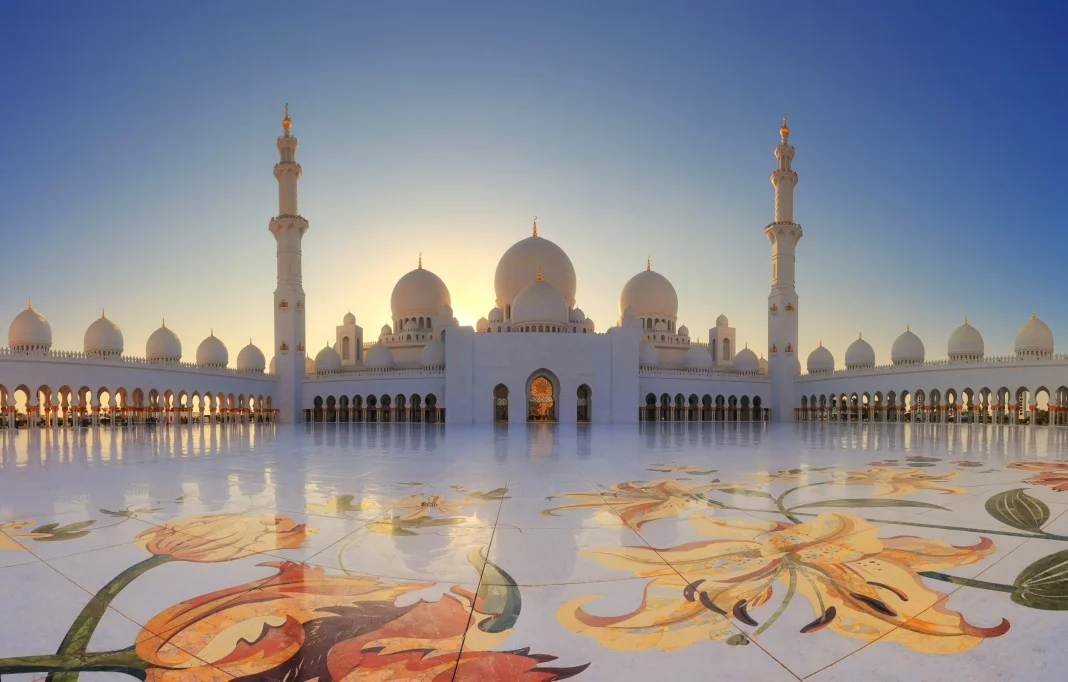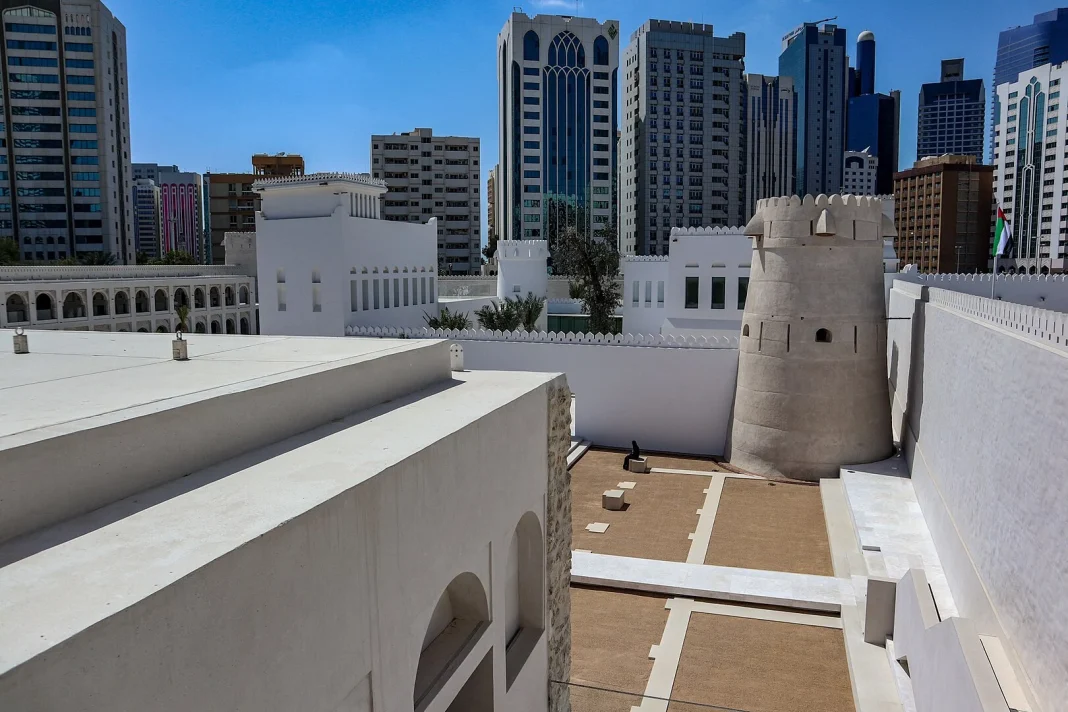The majesty of the Sheikh Zayed Grand Mosque has become a symbol that transcends the religious to embrace the cultural and touristic. Its white domes and stylized minarets attract millions of visitors every year, fascinated by the harmony between tradition and modernity. The mosque is not only a place of worship, but also a driver of urban and residential development in Abu Dhabi. The experience of walking through its courtyards and galleries turns into a sensory journey that multiplies the capital’s appeal. Source Freepik.
The Sheikh Zayed Grand Mosque stands as an architectural benchmark combining spirituality and international projection. Since its inauguration, it has been a magnet for tourists and residents, who find in its surroundings a place where beauty becomes a statement of identity. The economic impact of this enclave is reflected in the expansion of hotels, restaurants, and luxury homes that surround the area. The mosque, with its magnetism, has led Abu Dhabi to position itself as a global destination.
Urban growth around this monument has been as notable as its cultural influence. City planning has been shaped by the need to integrate residential and commercial spaces accompanying the influx of visitors. The mosque acts as a catalyst for investments, generating opportunities that go beyond tourism and reach the real estate market. Thus, Abu Dhabi has managed to turn a religious icon into an engine of comprehensive development.
A SPACE THAT UNITES TRADITION AND MODERNITY
The mosque presents itself as a bridge between past and present, where Islamic tradition merges with architectural innovation. Its imported marbles and handcrafted details evoke centuries of history, while its contemporary design reflects the ambition of a constantly evolving country. This balance makes the temple a global reference for how to preserve cultural heritage without renouncing progress. The experience of walking along its corridors is a journey that connects generations.
The visitor finds a space that not only invites spiritual contemplation but also reflection on cultural coexistence. The mosque has become a meeting point for people from different backgrounds, reinforcing Abu Dhabi’s image as a cosmopolitan city. The diversity of its visitors is a living testimony to its ability to attract and unite. Thus, tradition and modernity intertwine in the same setting.
TOURISM EXPANDS AROUND ITS MAGNETISM
The influx of visitors has driven the creation of guided tours, cultural programs, and activities that enrich Abu Dhabi’s touristic offer. The mosque has become a must-stop in any itinerary, generating a constant flow of travelers that energizes the local economy. Religious and cultural tourism merges with leisure and gastronomy, creating a vibrant ecosystem. The city has skillfully capitalized on this magnetism to diversify its appeal.
Tourism infrastructure has adapted to the demands of an international public, with services ranging from luxury hotels to more accessible options. This range of choices makes the experience inclusive and attractive for different visitor profiles. The mosque becomes the epicenter of an offer that combines spirituality and entertainment. Thus, Abu Dhabi strengthens its position as a global destination.
ARCHITECTURE AS AN EMBLEM OF IDENTITY
The mosque’s design is a statement of intent: to show the world the cultural richness of the United Arab Emirates. Its columns, mosaics, and domes reflect an aesthetic that combines classic Islamic influences with contemporary elements. Architecture becomes a universal language transmitting values of beauty and spirituality. Every detail is a reminder of Abu Dhabi’s ambition to place itself on the global cultural map.
The monumentality of the building impresses not only with its size but also with the delicacy of its finishes. The light filtering into its interiors creates an atmosphere that invites contemplation and introspection. Architecture becomes a resource to generate emotions and unique experiences. Thus, the mosque is reaffirmed as a symbol of national identity and collective pride.
RESIDENTIAL IMPACT MULTIPLIES IN ITS SURROUNDINGS
The mosque’s presence at Sheikh Zayed Grand Mosque has boosted the development of residential complexes seeking to harness its proximity. Demand for housing in the area has grown, motivated by the appeal of living close to a cultural and touristic icon. This phenomenon has raised property values, making the area one of the most coveted in Abu Dhabi. Thus, the mosque transforms not only the urban landscape but also the housing market.
Residents find in this environment a unique combination of prestige and convenience. Proximity to tourist and cultural services adds differential value to properties. The mosque becomes a selling point and a factor of constant revaluation. In this way, the residential impact multiplies, establishing the area as a strategic enclave.
A CULTURAL REFERENCE THAT TRANSCENDS BORDERS
The mosque not only attracts local visitors, but has become an international reference. Its image appears in tourism campaigns and publications seeking to showcase the United Arab Emirates’ cultural richness. The global projection of this monument reinforces the country’s identity on the international stage. Thus, the mosque transcends its religious role to become a symbol of openness and modernity.
International recognition has generated a multiplying effect in the perception of Abu Dhabi as a cultural destination. The mosque integrates into academic, artistic, and tourist circuits that position it as a global benchmark. Its ability to inspire and attract is an intangible asset that strengthens the country’s brand. Thus, the enclave is consolidated as universal heritage.
A FUTURE OF SUSTAINABLE GROWTH AROUND ITS INFLUENCE
Abu Dhabi’s urban planning considers the Sheikh Zayed Grand Mosque as the axis of sustainable development. The aim is to balance touristic and residential expansion with the preservation of its cultural environment. The strategic vision seeks to maintain appeal without compromising the site’s authenticity. This approach ensures the mosque continues to be a driver of responsible growth.
The future of the city is projected around this monument, with initiatives that promote innovation and inclusion. The mosque becomes a symbol of how to integrate tradition and progress in one space. Its influence extends beyond architecture, reaching the social and economic spheres. Thus, Abu Dhabi ensures sustainable growth that multiplies its touristic and residential value.



